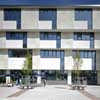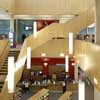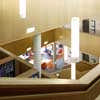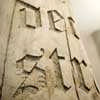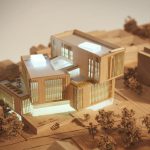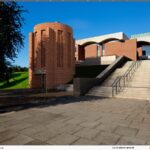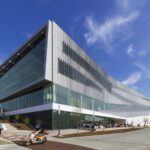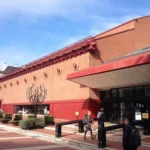Crawley Library, West Sussex Building, Project, Photo, Design, Property
Crawley Library Building, England
Development in southeast England, UK – design by Penoyre & Prasad Architects
28 May 2010
Crawley Library
West Sussex, England
2010
Design: Penoyre & Prasad, architects
Client’s Brief
Crawley Library creates a new major civic building and destination for the community comprising 2850sqm public library, 450sqm Register Office, together with 1170sqm Social Services facilities. Our brief was to develop these areas in an accessible and welcoming integrated development forming part of a long-term masterplan for the wider area around a new public open space, bringing together the various stakeholder in a timeless yet contemporary civic building. Consultation and community participation formed an important part of the client’s requirements and detailed aspects of the brief was developed through extensive liaison with library and registration service staff and end users.
The consultation drew on workshops with artists Gordon Young and Anna Sandberg which clarified library end user priorities and informed an art commission for a series of engraved oak columns carrying quotations of favourite books etched into the stripped oak trees. Sustainability was a high priority for the client and this is reflected in the sustainable low energy design which achieves a BREEAM rating of very good and extremely low carbon emissions: 11.94 kgCO2/sqm p.a. compared with 30.31 kg CO2/sqm p.a. permitted under Building Regulations.
Planning and Social Constraints – The Library forms a first phase of an extension to Crawley town centre. We worked with the county council, planning authority, English Partnerships (HCA), and developers to coordinate a masterplan for the phased long-term development of the area. The Library’s new public square forms the focus of this masterplan and will allow the diversion of Telford Place to create a vehicle-free heart to the neighbourhood in the next phase. The site acts as an important Gateway site into the town centre and early consultations with the planning authority highlighted concerns that a standalone library would not provide appropriate civic presence and massing. Our initial feasibility study informed an expansion of the client brief to include other local public services and an upper storey of administrative accommodation. This mix of uses allows the building mass to step down from four storeys facing the town centre to two storeys more in keeping with surrounding streetscape.
Materials and Method of Construction – The brief and prominent town centre location called for a building which expresses civic qualities suitable for public services in the 21st century. This was achieved through playful elevations exploring variations of rhythm between stone and glazed panels addressing the need for transparency to showcase facilities and provide good levels of daylight. The width of the panels is based on the width of a standard shelving unit, allowing a unique relationship between the exterior and interior whereby the books are actually embodied in the thickness of the building envelope. Subsequently freed-up floor space contributes to a light, airy and accessible interior. Designed as an exemplar for sustainable construction with Green Guide to Specification Class A building materials, the building form was developed to minimise energy consumption through a sophisticated mixed mode heating and ventilation strategy which informs the choice of materials throughout. Ventilation is regulated through BMS controlled actuators. In wintertime, tempered fresh air enters via raised floors across underfloor heating coils, and is extracted via a central heat recovery system at a wind trough at the top of the atrium. Renewable energy technologies used include central biomass and solar thermal hot water. A sedum roof contributes to biodiversity and rainwater attenuation. A lifecycle cost plan informed key specification choices to minimise whole life costs. Exposed roof finishes were replaced by ballasted systems. Hard wearing cladding materials such as Jura limestone, engineering brick and curtain walling were specified for accessible or vulnerable areas. Internal finishes in public library area are specified for durability.
Summary of timetable
Nov 2005 – Mar 2006: Site capacity and feasibility studies
Mar 2006 – Oct 2006: Outline and Scheme Design, Detailed Planning Submission
Nov 2006 – Jan 2007: RIBA Stage E Design and completion of ERs
Feb – Dec 2007: Production Information
May 2007 – Dec 2008: Construction Period
Dec 2008: Public Opening
Programme and budget constraints – From early design stages onwards a life cycle cost plan was developed which informs key aspects of the design to achieve long-term economies in operation, for example through low energy design, the use of robust long-life materials, and the integration of the library with other county council facilities for building management efficiencies. Design development was managed to achieve best value with costs regularly evaluated against design objectives to ensure decisions add real value. Spending was focused on obtaining high quality design and durability for public areas – for example focusing natural stone on principle elevations, and provision of metal rather than timber shelving, solid core laminate table tops, and chairs with robust stainless steel frames. The main contractor was selected through a two-stage IESE Framework process allowing costs and specification choices to be checked in relation to supply chain information immediately following completion of RIBA Stage D to achieve competitive pricing.
Crawley Library building images / information from Penoyre & Prasad 280510
Location:England
Sussex Buildings – Selection:
Chichester Regional Museum
Keith Williams Architects
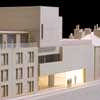
picture from architect firm
Chichester District Museum
, West Sussex
Heatherwick Studio
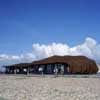
photo : Andy Stagg
Littlehampton Building
Comments / photos for the Crawley Library England Architecture page welcome
Crawley Library Building

